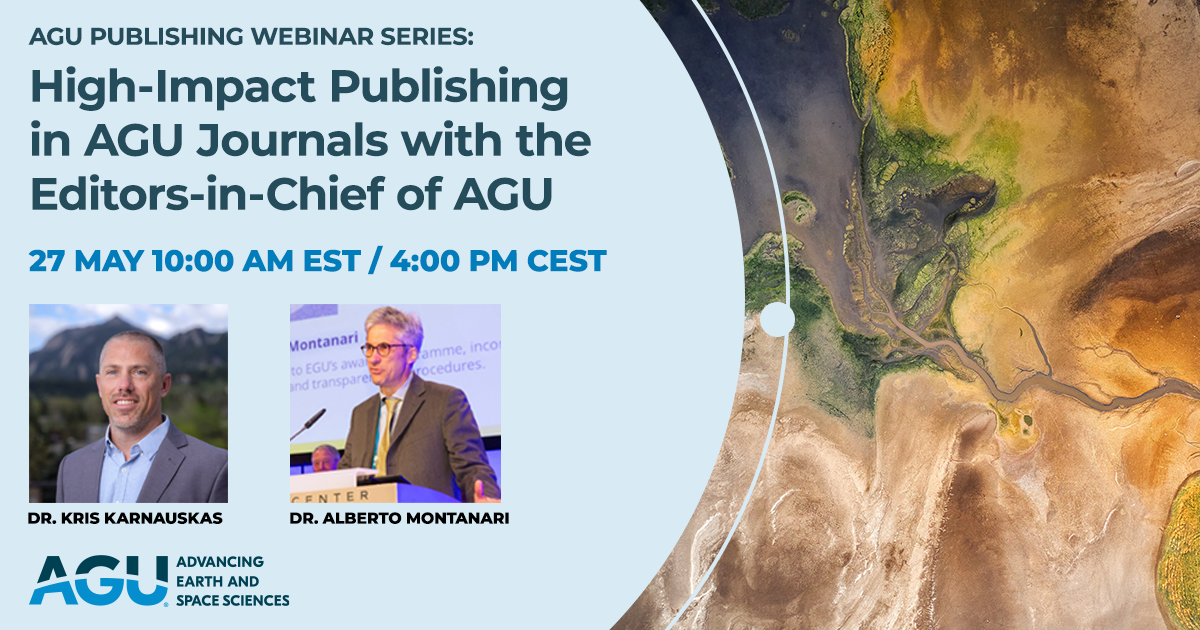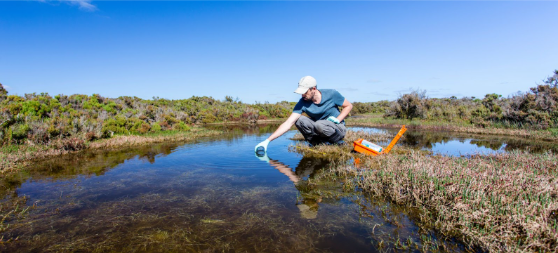AGU Advances
A cross-disciplinary, gold open-access journal publishing full length, high-impact research articles across all of the Earth and space sciences. Submit your research!
Volume 6 Issue 2 | April 2025
- UPCOMING EVENTS
- EDITORIALS
- COMMENTARY
- VIEWPOINTS
- RESEARCH ARTICLES
- EDITORS' PICKS FROM OTHER JOURNALS
- FEATURED AGU SPECIAL COLLECTION
FROM THE EDITOR IN CHIEF
This issue of AGU Advances hosts a timely editorial written by several Editors-in-Chief of AGU journals to comment on the recent Executive Orders in the U.S. that have censored research and researchers by banning specific words, removing access to data sets, and restricting what type of research can be funded or published. Editors advocate for the publication of evidence-based, rigorously vetted research free from political influence, driven by the belief that a diverse, equitable, and inclusive scientific community enhances the quality of science. A second editorial acknowledges the dedication of our peer reviewer for their continuous support during 2024, which resulted in high profile and constructive feedback to the authors. We also host a viewpoint by Almarez on the first trial of enhanced weathering in a California rangeland described by Anthony et al. (2025), who introduce paths for future research concerning combined amendment applications. Among the research articles, Co et al. investigate a record of soil moisture spanning over one thousand years, providing innovative insights into modern and historical rainfall-rich periods and shedding new light on the periodicity of climate. An interesting analysis and a comprehensive survey of high-speed electron flows in the Earth magnetotail surveyed by NASA through the Magnetospheric Multiscale (MMS) mission is presented by Liu et al. The Earth magnetotail is a key region of the magnetosphere where dramatic space weather activities can be triggered, endangering space-based facilities. Improving our understanding of such processes is crucial for increasing the security of communication systems. I hope this collection of papers provides a diverse and interdisciplinary new perspective on our comprehension of nature.
UPCOMING EVENTS

Join us on 27 May at 10:00 AM EST for an exclusive webinar with the Editors-in-Chief of AGU Advances (Dr. Alberto Montanari) and AGU Geophysical Research Letters (Dr. Kris Karnauskas). Take advantage of this chance to hear from the experts and ask your questions directly!
Register here:
https://agu.zoom.us/webinar/register/WN_z0pT2YNFR6GxDnRtDTmlhQ#/registration
EDITORIALS
Commitment to Advance Excellence and Inclusion in the Earth and Space Sciences Scholarly Publications
Recent Executive Orders in the U.S. have censored research and researchers by banning specific words, removing access to data sets, and restricting what type of research can be funded or published. Editors-in-Chief of AGU publications stand by our mission to support the publication of evidence-based, rigorously vetted research without political pressure.
Thank You to Our 2024 Reviewers
The editorial team of AGU Advances is grateful for the excellent contributions of our peer reviewers, 273 of whom, representing 24 countries, contributed 338 reviews in 2024.
COMMENTARY
Better Monitoring is Needed for Climate Change in the Upper Atmosphere
A new commentary calls for a better understanding of the impacts of climate change and anthropogenic emissions on long-term trends of the middle and upper atmosphere through enhanced observations and monitoring capabilities.
The Known Unknowns of Petrogenic Organic Carbon in Soils
Soil carbon models generally ignore rock-derived carbon, limiting models of carbon storage and highlighting the need for cross-disciplinary research on rock-derived carbon in soil.
Anthropocene Deserves Official Recognition, Some Experts Maintain
The International Union of Geological Sciences chose not to designate a new geologic epoch, but the matter is not yet settled. . .
VIEWPOINTS
Enhanced Weathering May Benefit From Co-Application With Organic Amendments
Almarez discusses this issue’s article from Anthony et al. (2025) investigating how compost and biochar help boost carbon sequestration by crushed rock.
RESEARCH ARTICLES
Deflected Dikes Perturb the Plumbing System
A multidisciplinary synthesis of the Campi Flegrei, Italy volcanic setting highlights the importance of sub-caldera layering for magma dynamics.
Constraining Earth's Radiative Tropopause Temperature
Using water vapor spectroscopy and thermodynamics, McKim et al. add support for hypotheses illuminating the role of wavelength-dependent radiation physics in the effects on Earth’s atmosphere from global warming.
Compost and Biochar Could Boost Carbon Sequestration by Crushed Rock
Crushed rock additives may also help decrease soil emissions of other greenhouse gases, such as nitrous oxide and methane. Viewpoint by Almaraz et al.
Tonga’s Volcanic Fury Ripples to the Netherworld
Secondary gravity waves emerge as the hidden architects of global-scale thermospheric upheaval following the Tonga eruption in 2022.
Fire, Fuel, and Climate Interactions in Temperate Climates
As warmer temperatures lengthen fire seasons, new research identifies how vegetation and weather impact the extent of future wildfires, particularly in the wettest areas.
Modelling pH Trends in Coastal Waters
In coastal waters, new work examining the interplay of river alkalinization and ocean acidification on pH suggest that ocean alkalinity enhancement could mitigate acidification.
Hawai’i’s Depleted Peridotite Delivers More Magma
The source for the isotopically-enriched Hawaiian magmas contains peridotites that experienced near-surface melting prior incorporation in the plume.
Matching Magma Dikes May Have Different Flow Patterns
A set of lab experiments involving a laser, gelatin, and xanthan gum explored how varying flow patterns between dikes with similar speeds and shapes could affect eruption predictions.
Fast Flows in Earth’s Magnetotail Surveyed by NASA Satellites
A survey of high-speed electron flow observed by NASA satellites in the Earth’s magnetotail is presented and related to the process of magnetic field line reconnection and particle acceleration.
Investigating Rainfall-Rich Periods in North America
A record of soil moisture that extends over one thousand years allows for the investigation of occurrence and causes of modern and historical rainfall-rich periods.
Modeling the Past, Present, and Future of Drought
A new study combines historical observations, climate modeling, and data from tree rings to create a fuller picture of historic as well as potential drought conditions.
What Is Causing the Missouri River Basin’s Elevated Streamflow?
Regional climate variability plays a big role, but reduced forest cover and a rise in atmospheric carbon dioxide are also factors.
Examining Formation of Sub-Antarctic Mode Waters
Using a model of the Southern Ocean, new research addresses the roles of densification of south-flowing subtropical waters vs lightening of north-flowing Antarctic waters in sub-Antarctic mode waters.
Forest Loss in the Amazon Affects Dry Season Precipitation
Extensive deforestation in the Amazon causes significant reductions in the amount of precipitation in the dry season due to reduced moisture recycling.
Daily Satellite Data for Detecting Floods and Extreme Heat
iUsing an open-source framework and daily satellite data, the authors identified up to 2.5x more flood events and increased the detected area of heat hazards by 56%.
How (Slow) Earthquakes Get Going
Non-volcanic tremor ramp up precedes slow slip in Cascadia by about a day, indicating that brittle-creeping process interactions control nucleation.
300 Million Years of Polar Wander: Slowly but Surely
A reanalysis of paleomagnetic poles provides tighter bounds on the style and rate of motions of our whole planet with respect to its rotation axis.
EDITORS' PICKS FROM OTHER JOURNALS
Phytoplankton Blooms
Chapman et al. (2025) find that phytoplankton blooms, often seen near the separation point of western boundary currents, are supported by nutrient supply upwelling and cross-shelf transport. –, Journal of Geophysical Research: Oceans
Water on Mars
Water may have been present within the crust of ancient Mars in hydrothermal systems circulating under craters, argue Mittelholz et al. (2025), who use inversions of orbital gravity and magnetic field data to show the geophysical effects the presence of these ancient, long-lasting hydrothermal systems would have on Mars’ crust. –, Journal of Geophysical Research: Planets
Dust and Glaciers
Snow on New Zealand’s Southern Alps turned from white to red in 2019-2020. Winton et al. (2024) show that the color change likely resulted from red desert dust carried across the Tasman Sea after severe bushfires in Australia and could impact glacial melting. –, Geophysical Research Letters
FEATURED AGU SPECIAL COLLECTION

This joint special collection between Earth’s Future, GeoHealth, and Perspectives of Earth and Space Scientists focuses on the critical and timely issue of human impact on terrestrial ecosystems. As population growth and land use intensify, ecosystems essential for biodiversity, climate regulation, and human well-being face unprecedented threats. Land degradation and unsustainable agricultural practices exacerbate environmental decline, undermining ecosystem services like carbon sequestration, water regulation, and food production. This interdisciplinary collection invites researchers, policymakers, and practitioners to explore innovative strategies for carbon management, particularly in the context of climate change mitigation. Contributions from diverse fields — including ecology, environmental science, and economics — are welcomed to foster a comprehensive understanding of human environment interactions.
See the call for papers here:
https://agupubs.onlinelibrary.wiley.com/hub/journal/24711403/homepage/call-for-papers/si-2024-001082

